AAMC FNSSAM403: Prospecting for New Clients - Assignment Solution
VerifiedAdded on 2021/08/03
|35
|11275
|254
Homework Assignment
AI Summary
This document is a comprehensive learning guide and assignment solution for the FNSSAM403 module, focusing on prospecting for new clients. It covers essential topics such as creating rapport with prospective clients, finding prospects, and planning effective prospecting strategies. The guide details various prospecting methods including cold calling, referrals, content marketing, networking, email marketing, seminars, and social networking. It also provides insights into the initial contact process, determining a prospective client's understanding of financial processes, and the role of advisors. The assignment further delves into identifying prospective client's needs, understanding buying motives, risk profiling, and marketing techniques. Furthermore, the guide discusses securing commitment, addressing sales resistance, gathering client details, and managing prospective client information. It also emphasizes the importance of establishing a prospect database, researching options, and preparing for future contacts, providing a complete overview of the sales and client acquisition process.
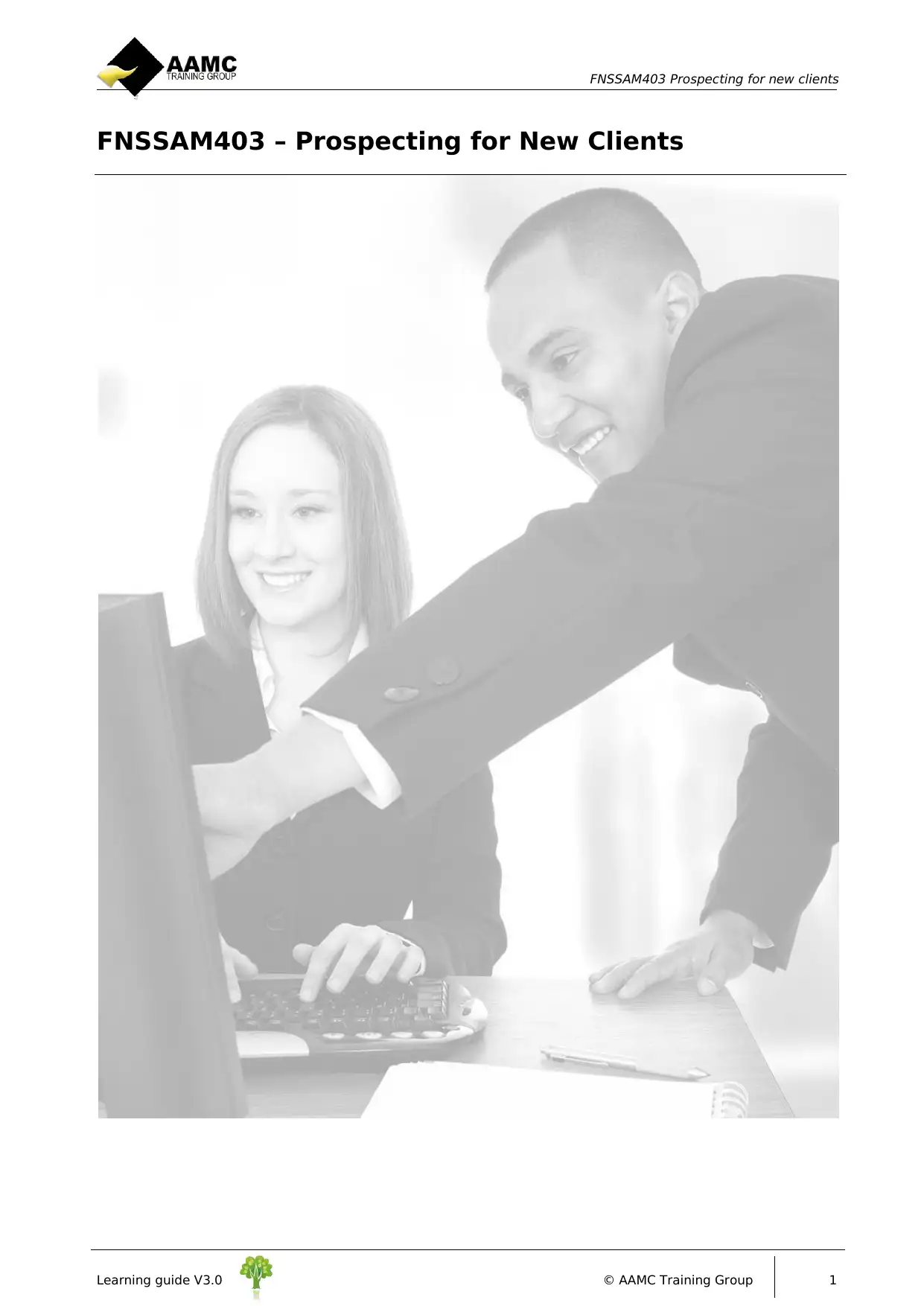
FNSSAM403 Prospecting for new clients
Learning guide V3.0 © AAMC Training Group 1
FNSSAM403 – Prospecting for New Clients
Learning guide V3.0 © AAMC Training Group 1
FNSSAM403 – Prospecting for New Clients
Paraphrase This Document
Need a fresh take? Get an instant paraphrase of this document with our AI Paraphraser

FNSSAM403 Prospecting for new clients
2 © AAMC Training Group Learning guide V3.0
Contents
Section 1 Create rapport with prospective client 3
Finding prospects and planning a prospecting strategy 4
Prospecting methods 5
Initial contact 7
Determine prospective client’s understanding of financial processes 8
Role of advisers and organisation 11
Section 2 Identify prospective client’s needs 13
Understanding prospects’ needs 13
Buying motives 15
Risk profiling 16
Marketing techniques 18
Section 3 Secure commitment 21
Sales resistance 21
Gather prospect’s personal, financial and business details and providing appropriate options 23
Next steps 28
Section 4 Manage prospective client information 29
Managing prospective customer and client information 29
Establishing a prospect database 32
Research range of options 34
Prepare for the next contact 34
2 © AAMC Training Group Learning guide V3.0
Contents
Section 1 Create rapport with prospective client 3
Finding prospects and planning a prospecting strategy 4
Prospecting methods 5
Initial contact 7
Determine prospective client’s understanding of financial processes 8
Role of advisers and organisation 11
Section 2 Identify prospective client’s needs 13
Understanding prospects’ needs 13
Buying motives 15
Risk profiling 16
Marketing techniques 18
Section 3 Secure commitment 21
Sales resistance 21
Gather prospect’s personal, financial and business details and providing appropriate options 23
Next steps 28
Section 4 Manage prospective client information 29
Managing prospective customer and client information 29
Establishing a prospect database 32
Research range of options 34
Prepare for the next contact 34
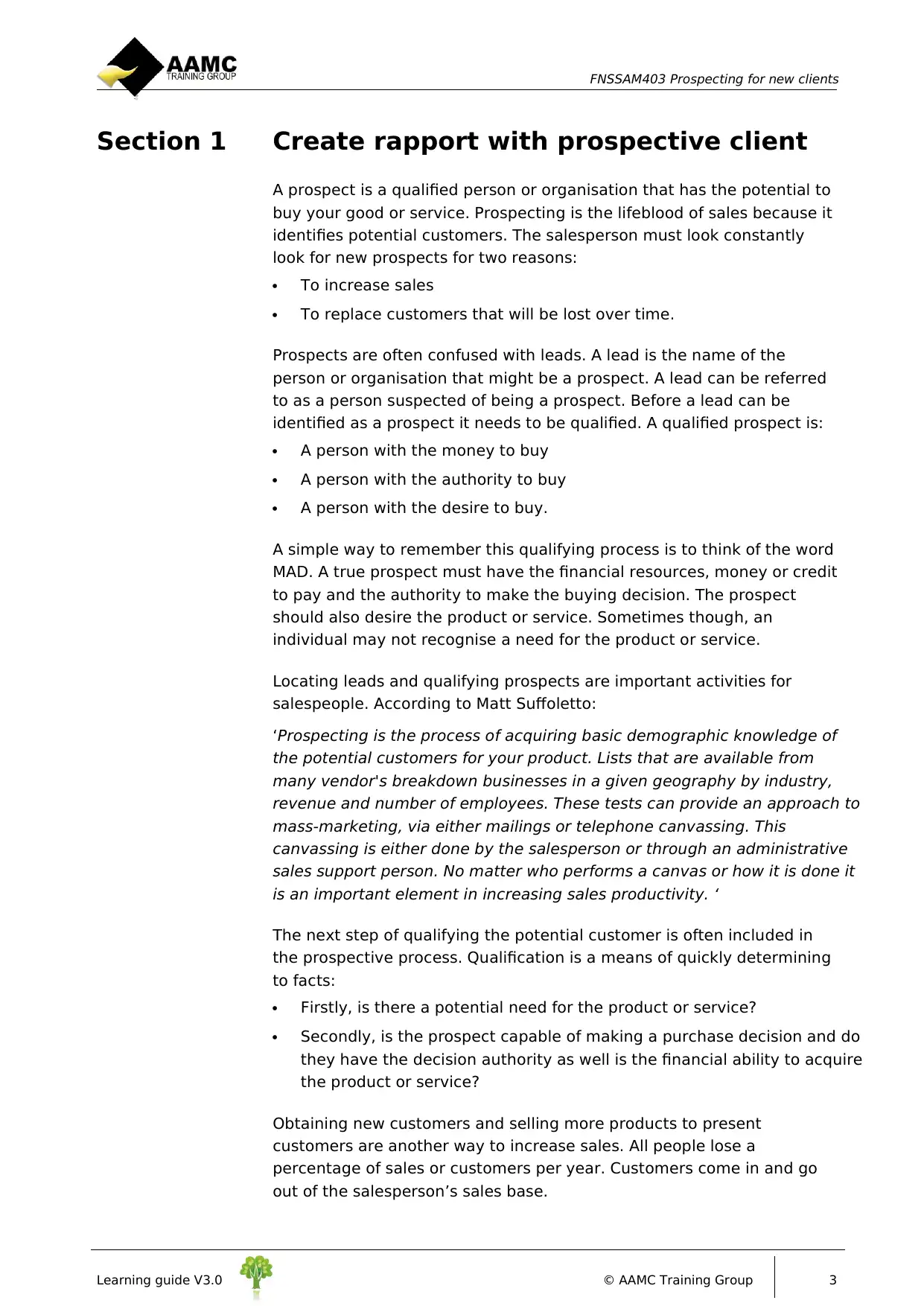
FNSSAM403 Prospecting for new clients
Learning guide V3.0 © AAMC Training Group 3
Section 1 Create rapport with prospective client
A prospect is a qualified person or organisation that has the potential to
buy your good or service. Prospecting is the lifeblood of sales because it
identifies potential customers. The salesperson must look constantly
look for new prospects for two reasons:
To increase sales
To replace customers that will be lost over time.
Prospects are often confused with leads. A lead is the name of the
person or organisation that might be a prospect. A lead can be referred
to as a person suspected of being a prospect. Before a lead can be
identified as a prospect it needs to be qualified. A qualified prospect is:
A person with the money to buy
A person with the authority to buy
A person with the desire to buy.
A simple way to remember this qualifying process is to think of the word
MAD. A true prospect must have the financial resources, money or credit
to pay and the authority to make the buying decision. The prospect
should also desire the product or service. Sometimes though, an
individual may not recognise a need for the product or service.
Locating leads and qualifying prospects are important activities for
salespeople. According to Matt Suffoletto:
‘Prospecting is the process of acquiring basic demographic knowledge of
the potential customers for your product. Lists that are available from
many vendor's breakdown businesses in a given geography by industry,
revenue and number of employees. These tests can provide an approach to
mass-marketing, via either mailings or telephone canvassing. This
canvassing is either done by the salesperson or through an administrative
sales support person. No matter who performs a canvas or how it is done it
is an important element in increasing sales productivity. ‘
The next step of qualifying the potential customer is often included in
the prospective process. Qualification is a means of quickly determining
to facts:
Firstly, is there a potential need for the product or service?
Secondly, is the prospect capable of making a purchase decision and do
they have the decision authority as well is the financial ability to acquire
the product or service?
Obtaining new customers and selling more products to present
customers are another way to increase sales. All people lose a
percentage of sales or customers per year. Customers come in and go
out of the salesperson’s sales base.
Learning guide V3.0 © AAMC Training Group 3
Section 1 Create rapport with prospective client
A prospect is a qualified person or organisation that has the potential to
buy your good or service. Prospecting is the lifeblood of sales because it
identifies potential customers. The salesperson must look constantly
look for new prospects for two reasons:
To increase sales
To replace customers that will be lost over time.
Prospects are often confused with leads. A lead is the name of the
person or organisation that might be a prospect. A lead can be referred
to as a person suspected of being a prospect. Before a lead can be
identified as a prospect it needs to be qualified. A qualified prospect is:
A person with the money to buy
A person with the authority to buy
A person with the desire to buy.
A simple way to remember this qualifying process is to think of the word
MAD. A true prospect must have the financial resources, money or credit
to pay and the authority to make the buying decision. The prospect
should also desire the product or service. Sometimes though, an
individual may not recognise a need for the product or service.
Locating leads and qualifying prospects are important activities for
salespeople. According to Matt Suffoletto:
‘Prospecting is the process of acquiring basic demographic knowledge of
the potential customers for your product. Lists that are available from
many vendor's breakdown businesses in a given geography by industry,
revenue and number of employees. These tests can provide an approach to
mass-marketing, via either mailings or telephone canvassing. This
canvassing is either done by the salesperson or through an administrative
sales support person. No matter who performs a canvas or how it is done it
is an important element in increasing sales productivity. ‘
The next step of qualifying the potential customer is often included in
the prospective process. Qualification is a means of quickly determining
to facts:
Firstly, is there a potential need for the product or service?
Secondly, is the prospect capable of making a purchase decision and do
they have the decision authority as well is the financial ability to acquire
the product or service?
Obtaining new customers and selling more products to present
customers are another way to increase sales. All people lose a
percentage of sales or customers per year. Customers come in and go
out of the salesperson’s sales base.
⊘ This is a preview!⊘
Do you want full access?
Subscribe today to unlock all pages.

Trusted by 1+ million students worldwide
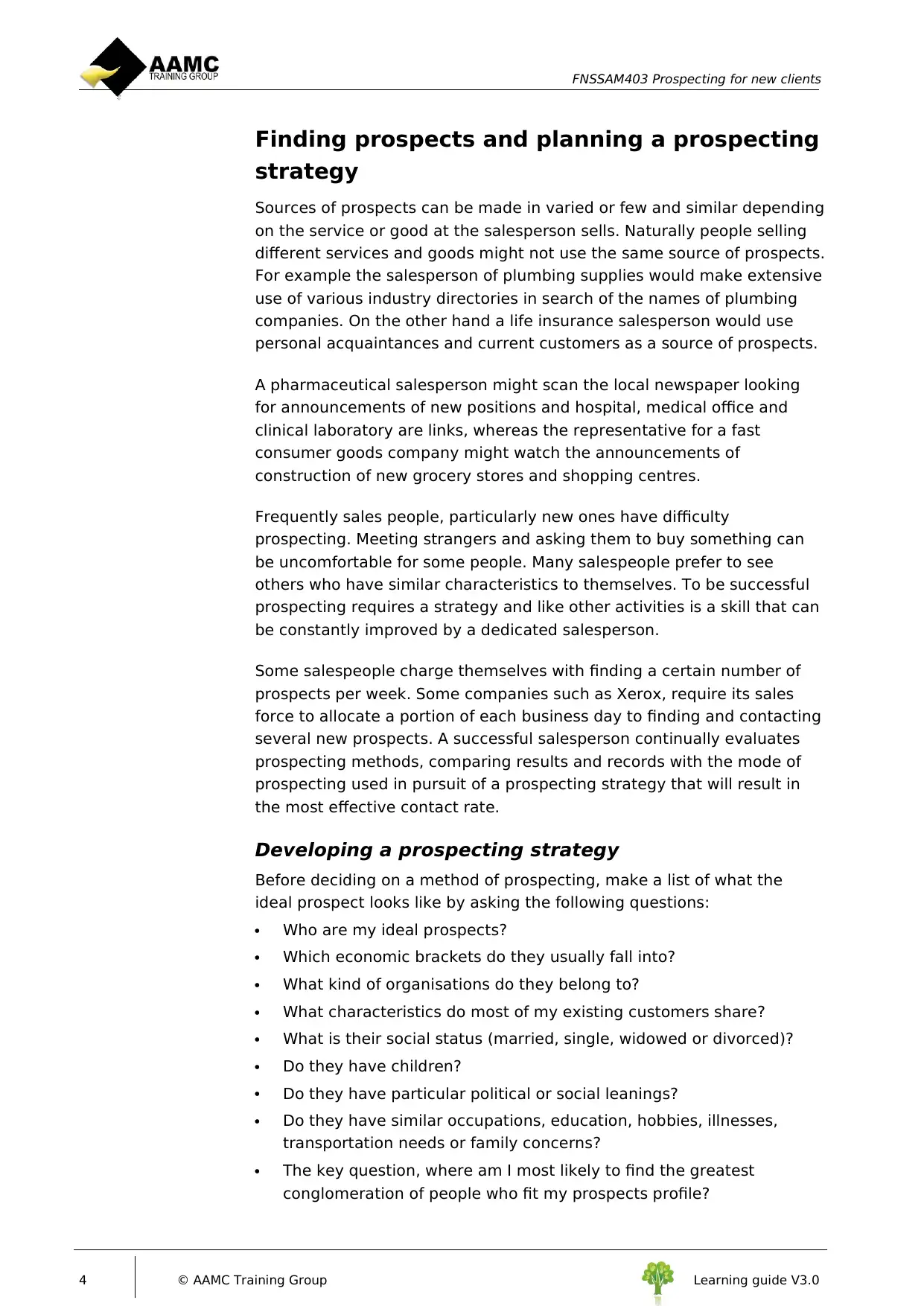
FNSSAM403 Prospecting for new clients
4 © AAMC Training Group Learning guide V3.0
Finding prospects and planning a prospecting
strategy
Sources of prospects can be made in varied or few and similar depending
on the service or good at the salesperson sells. Naturally people selling
different services and goods might not use the same source of prospects.
For example the salesperson of plumbing supplies would make extensive
use of various industry directories in search of the names of plumbing
companies. On the other hand a life insurance salesperson would use
personal acquaintances and current customers as a source of prospects.
A pharmaceutical salesperson might scan the local newspaper looking
for announcements of new positions and hospital, medical office and
clinical laboratory are links, whereas the representative for a fast
consumer goods company might watch the announcements of
construction of new grocery stores and shopping centres.
Frequently sales people, particularly new ones have difficulty
prospecting. Meeting strangers and asking them to buy something can
be uncomfortable for some people. Many salespeople prefer to see
others who have similar characteristics to themselves. To be successful
prospecting requires a strategy and like other activities is a skill that can
be constantly improved by a dedicated salesperson.
Some salespeople charge themselves with finding a certain number of
prospects per week. Some companies such as Xerox, require its sales
force to allocate a portion of each business day to finding and contacting
several new prospects. A successful salesperson continually evaluates
prospecting methods, comparing results and records with the mode of
prospecting used in pursuit of a prospecting strategy that will result in
the most effective contact rate.
Developing a prospecting strategy
Before deciding on a method of prospecting, make a list of what the
ideal prospect looks like by asking the following questions:
Who are my ideal prospects?
Which economic brackets do they usually fall into?
What kind of organisations do they belong to?
What characteristics do most of my existing customers share?
What is their social status (married, single, widowed or divorced)?
Do they have children?
Do they have particular political or social leanings?
Do they have similar occupations, education, hobbies, illnesses,
transportation needs or family concerns?
The key question, where am I most likely to find the greatest
conglomeration of people who fit my prospects profile?
4 © AAMC Training Group Learning guide V3.0
Finding prospects and planning a prospecting
strategy
Sources of prospects can be made in varied or few and similar depending
on the service or good at the salesperson sells. Naturally people selling
different services and goods might not use the same source of prospects.
For example the salesperson of plumbing supplies would make extensive
use of various industry directories in search of the names of plumbing
companies. On the other hand a life insurance salesperson would use
personal acquaintances and current customers as a source of prospects.
A pharmaceutical salesperson might scan the local newspaper looking
for announcements of new positions and hospital, medical office and
clinical laboratory are links, whereas the representative for a fast
consumer goods company might watch the announcements of
construction of new grocery stores and shopping centres.
Frequently sales people, particularly new ones have difficulty
prospecting. Meeting strangers and asking them to buy something can
be uncomfortable for some people. Many salespeople prefer to see
others who have similar characteristics to themselves. To be successful
prospecting requires a strategy and like other activities is a skill that can
be constantly improved by a dedicated salesperson.
Some salespeople charge themselves with finding a certain number of
prospects per week. Some companies such as Xerox, require its sales
force to allocate a portion of each business day to finding and contacting
several new prospects. A successful salesperson continually evaluates
prospecting methods, comparing results and records with the mode of
prospecting used in pursuit of a prospecting strategy that will result in
the most effective contact rate.
Developing a prospecting strategy
Before deciding on a method of prospecting, make a list of what the
ideal prospect looks like by asking the following questions:
Who are my ideal prospects?
Which economic brackets do they usually fall into?
What kind of organisations do they belong to?
What characteristics do most of my existing customers share?
What is their social status (married, single, widowed or divorced)?
Do they have children?
Do they have particular political or social leanings?
Do they have similar occupations, education, hobbies, illnesses,
transportation needs or family concerns?
The key question, where am I most likely to find the greatest
conglomeration of people who fit my prospects profile?
Paraphrase This Document
Need a fresh take? Get an instant paraphrase of this document with our AI Paraphraser
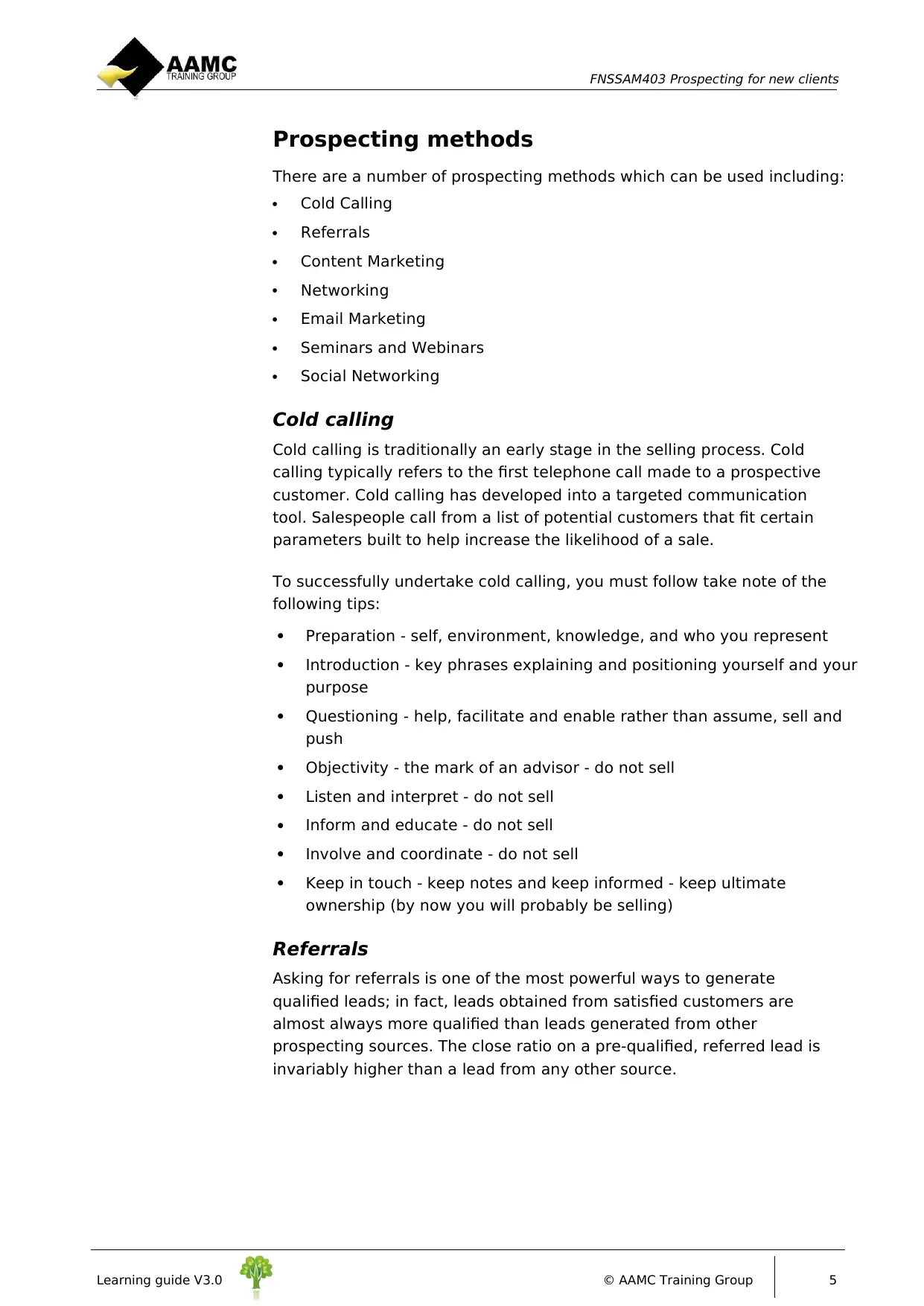
FNSSAM403 Prospecting for new clients
Learning guide V3.0 © AAMC Training Group 5
Prospecting methods
There are a number of prospecting methods which can be used including:
Cold Calling
Referrals
Content Marketing
Networking
Email Marketing
Seminars and Webinars
Social Networking
Cold calling
Cold calling is traditionally an early stage in the selling process. Cold
calling typically refers to the first telephone call made to a prospective
customer. Cold calling has developed into a targeted communication
tool. Salespeople call from a list of potential customers that fit certain
parameters built to help increase the likelihood of a sale.
To successfully undertake cold calling, you must follow take note of the
following tips:
Preparation - self, environment, knowledge, and who you represent
Introduction - key phrases explaining and positioning yourself and your
purpose
Questioning - help, facilitate and enable rather than assume, sell and
push
Objectivity - the mark of an advisor - do not sell
Listen and interpret - do not sell
Inform and educate - do not sell
Involve and coordinate - do not sell
Keep in touch - keep notes and keep informed - keep ultimate
ownership (by now you will probably be selling)
Referrals
Asking for referrals is one of the most powerful ways to generate
qualified leads; in fact, leads obtained from satisfied customers are
almost always more qualified than leads generated from other
prospecting sources. The close ratio on a pre-qualified, referred lead is
invariably higher than a lead from any other source.
Learning guide V3.0 © AAMC Training Group 5
Prospecting methods
There are a number of prospecting methods which can be used including:
Cold Calling
Referrals
Content Marketing
Networking
Email Marketing
Seminars and Webinars
Social Networking
Cold calling
Cold calling is traditionally an early stage in the selling process. Cold
calling typically refers to the first telephone call made to a prospective
customer. Cold calling has developed into a targeted communication
tool. Salespeople call from a list of potential customers that fit certain
parameters built to help increase the likelihood of a sale.
To successfully undertake cold calling, you must follow take note of the
following tips:
Preparation - self, environment, knowledge, and who you represent
Introduction - key phrases explaining and positioning yourself and your
purpose
Questioning - help, facilitate and enable rather than assume, sell and
push
Objectivity - the mark of an advisor - do not sell
Listen and interpret - do not sell
Inform and educate - do not sell
Involve and coordinate - do not sell
Keep in touch - keep notes and keep informed - keep ultimate
ownership (by now you will probably be selling)
Referrals
Asking for referrals is one of the most powerful ways to generate
qualified leads; in fact, leads obtained from satisfied customers are
almost always more qualified than leads generated from other
prospecting sources. The close ratio on a pre-qualified, referred lead is
invariably higher than a lead from any other source.
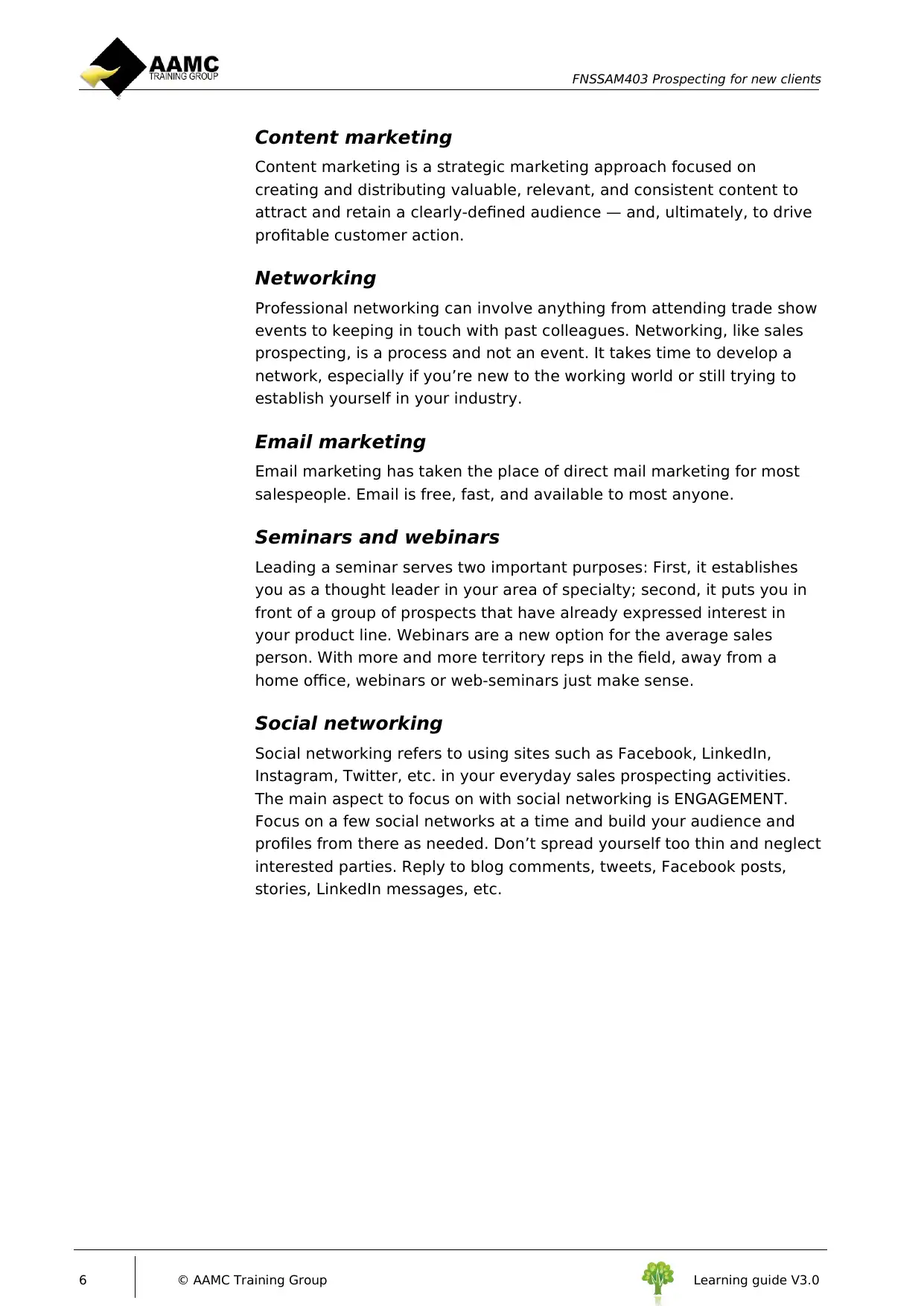
FNSSAM403 Prospecting for new clients
6 © AAMC Training Group Learning guide V3.0
Content marketing
Content marketing is a strategic marketing approach focused on
creating and distributing valuable, relevant, and consistent content to
attract and retain a clearly-defined audience — and, ultimately, to drive
profitable customer action.
Networking
Professional networking can involve anything from attending trade show
events to keeping in touch with past colleagues. Networking, like sales
prospecting, is a process and not an event. It takes time to develop a
network, especially if you’re new to the working world or still trying to
establish yourself in your industry.
Email marketing
Email marketing has taken the place of direct mail marketing for most
salespeople. Email is free, fast, and available to most anyone.
Seminars and webinars
Leading a seminar serves two important purposes: First, it establishes
you as a thought leader in your area of specialty; second, it puts you in
front of a group of prospects that have already expressed interest in
your product line. Webinars are a new option for the average sales
person. With more and more territory reps in the field, away from a
home office, webinars or web-seminars just make sense.
Social networking
Social networking refers to using sites such as Facebook, LinkedIn,
Instagram, Twitter, etc. in your everyday sales prospecting activities.
The main aspect to focus on with social networking is ENGAGEMENT.
Focus on a few social networks at a time and build your audience and
profiles from there as needed. Don’t spread yourself too thin and neglect
interested parties. Reply to blog comments, tweets, Facebook posts,
stories, LinkedIn messages, etc.
6 © AAMC Training Group Learning guide V3.0
Content marketing
Content marketing is a strategic marketing approach focused on
creating and distributing valuable, relevant, and consistent content to
attract and retain a clearly-defined audience — and, ultimately, to drive
profitable customer action.
Networking
Professional networking can involve anything from attending trade show
events to keeping in touch with past colleagues. Networking, like sales
prospecting, is a process and not an event. It takes time to develop a
network, especially if you’re new to the working world or still trying to
establish yourself in your industry.
Email marketing
Email marketing has taken the place of direct mail marketing for most
salespeople. Email is free, fast, and available to most anyone.
Seminars and webinars
Leading a seminar serves two important purposes: First, it establishes
you as a thought leader in your area of specialty; second, it puts you in
front of a group of prospects that have already expressed interest in
your product line. Webinars are a new option for the average sales
person. With more and more territory reps in the field, away from a
home office, webinars or web-seminars just make sense.
Social networking
Social networking refers to using sites such as Facebook, LinkedIn,
Instagram, Twitter, etc. in your everyday sales prospecting activities.
The main aspect to focus on with social networking is ENGAGEMENT.
Focus on a few social networks at a time and build your audience and
profiles from there as needed. Don’t spread yourself too thin and neglect
interested parties. Reply to blog comments, tweets, Facebook posts,
stories, LinkedIn messages, etc.
⊘ This is a preview!⊘
Do you want full access?
Subscribe today to unlock all pages.

Trusted by 1+ million students worldwide
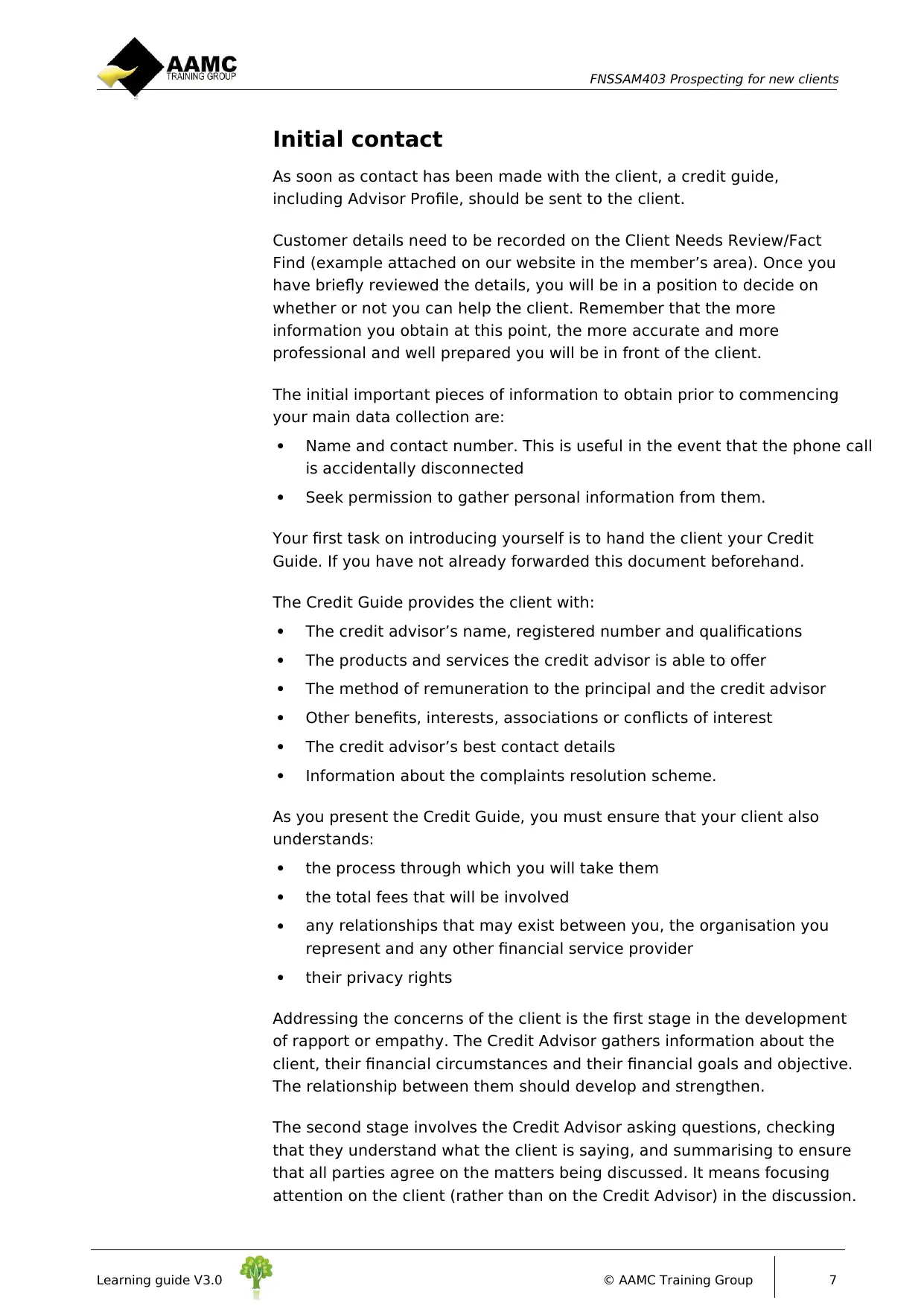
FNSSAM403 Prospecting for new clients
Learning guide V3.0 © AAMC Training Group 7
Initial contact
As soon as contact has been made with the client, a credit guide,
including Advisor Profile, should be sent to the client.
Customer details need to be recorded on the Client Needs Review/Fact
Find (example attached on our website in the member’s area). Once you
have briefly reviewed the details, you will be in a position to decide on
whether or not you can help the client. Remember that the more
information you obtain at this point, the more accurate and more
professional and well prepared you will be in front of the client.
The initial important pieces of information to obtain prior to commencing
your main data collection are:
Name and contact number. This is useful in the event that the phone call
is accidentally disconnected
Seek permission to gather personal information from them.
Your first task on introducing yourself is to hand the client your Credit
Guide. If you have not already forwarded this document beforehand.
The Credit Guide provides the client with:
The credit advisor’s name, registered number and qualifications
The products and services the credit advisor is able to offer
The method of remuneration to the principal and the credit advisor
Other benefits, interests, associations or conflicts of interest
The credit advisor’s best contact details
Information about the complaints resolution scheme.
As you present the Credit Guide, you must ensure that your client also
understands:
the process through which you will take them
the total fees that will be involved
any relationships that may exist between you, the organisation you
represent and any other financial service provider
their privacy rights
Addressing the concerns of the client is the first stage in the development
of rapport or empathy. The Credit Advisor gathers information about the
client, their financial circumstances and their financial goals and objective.
The relationship between them should develop and strengthen.
The second stage involves the Credit Advisor asking questions, checking
that they understand what the client is saying, and summarising to ensure
that all parties agree on the matters being discussed. It means focusing
attention on the client (rather than on the Credit Advisor) in the discussion.
Learning guide V3.0 © AAMC Training Group 7
Initial contact
As soon as contact has been made with the client, a credit guide,
including Advisor Profile, should be sent to the client.
Customer details need to be recorded on the Client Needs Review/Fact
Find (example attached on our website in the member’s area). Once you
have briefly reviewed the details, you will be in a position to decide on
whether or not you can help the client. Remember that the more
information you obtain at this point, the more accurate and more
professional and well prepared you will be in front of the client.
The initial important pieces of information to obtain prior to commencing
your main data collection are:
Name and contact number. This is useful in the event that the phone call
is accidentally disconnected
Seek permission to gather personal information from them.
Your first task on introducing yourself is to hand the client your Credit
Guide. If you have not already forwarded this document beforehand.
The Credit Guide provides the client with:
The credit advisor’s name, registered number and qualifications
The products and services the credit advisor is able to offer
The method of remuneration to the principal and the credit advisor
Other benefits, interests, associations or conflicts of interest
The credit advisor’s best contact details
Information about the complaints resolution scheme.
As you present the Credit Guide, you must ensure that your client also
understands:
the process through which you will take them
the total fees that will be involved
any relationships that may exist between you, the organisation you
represent and any other financial service provider
their privacy rights
Addressing the concerns of the client is the first stage in the development
of rapport or empathy. The Credit Advisor gathers information about the
client, their financial circumstances and their financial goals and objective.
The relationship between them should develop and strengthen.
The second stage involves the Credit Advisor asking questions, checking
that they understand what the client is saying, and summarising to ensure
that all parties agree on the matters being discussed. It means focusing
attention on the client (rather than on the Credit Advisor) in the discussion.
Paraphrase This Document
Need a fresh take? Get an instant paraphrase of this document with our AI Paraphraser

FNSSAM403 Prospecting for new clients
8 © AAMC Training Group Learning guide V3.0
Determine prospective client’s understanding
of financial processes
Prior to making recommendations to a client, it is necessary for you to gain
an understanding of the clients' financial situation at the outset. You should
then evaluate to what extent the client's financial goals, needs and
priorities can be met by the client's resources and current course of action.
Questioning techniques
When you ask the right questions in the right way, you can end up
getting your prospects to do all the selling for you! At the very least,
you'll learn a lot about what the prospect wants from your product -
which means you can laser-focus your presentation on just those points
that will sell most effectively.
Asking your prospect a series of open-ended questions during your
presentation serves three important purposes. First, it helps you to
confirm whether or not the prospect is a good fit for your product.
Second, it helps you to identify their hot-button benefits, which in turn
allows you to fine-tune your pitch. And third, by getting them to talk
about various benefits and what they think about them, you sneak the
information past the prospect’s “salesperson filter.”
Not every question listed here is a perfect fit for every prospect, but
these examples will give you a good place to start. Ideally, once you ask
a few questions, the prospect will launch into an in-depth speech and
you won’t need to do any more prompting at all.
Rapport-building questions
These questions get your prospect talking about himself and help you
develop some level of rapport with him (and also help you find out the
prospect’s likes and dislikes, which can help quite a bit).
How long have you been with the company? (for business-to-business
or B2B sales)
Where did you buy that beautiful sofa? (business-to-customer or B2C
sales)
How old are your children? How many do you have? (If you see a photo)
What would you like this [product type] to do for you?
8 © AAMC Training Group Learning guide V3.0
Determine prospective client’s understanding
of financial processes
Prior to making recommendations to a client, it is necessary for you to gain
an understanding of the clients' financial situation at the outset. You should
then evaluate to what extent the client's financial goals, needs and
priorities can be met by the client's resources and current course of action.
Questioning techniques
When you ask the right questions in the right way, you can end up
getting your prospects to do all the selling for you! At the very least,
you'll learn a lot about what the prospect wants from your product -
which means you can laser-focus your presentation on just those points
that will sell most effectively.
Asking your prospect a series of open-ended questions during your
presentation serves three important purposes. First, it helps you to
confirm whether or not the prospect is a good fit for your product.
Second, it helps you to identify their hot-button benefits, which in turn
allows you to fine-tune your pitch. And third, by getting them to talk
about various benefits and what they think about them, you sneak the
information past the prospect’s “salesperson filter.”
Not every question listed here is a perfect fit for every prospect, but
these examples will give you a good place to start. Ideally, once you ask
a few questions, the prospect will launch into an in-depth speech and
you won’t need to do any more prompting at all.
Rapport-building questions
These questions get your prospect talking about himself and help you
develop some level of rapport with him (and also help you find out the
prospect’s likes and dislikes, which can help quite a bit).
How long have you been with the company? (for business-to-business
or B2B sales)
Where did you buy that beautiful sofa? (business-to-customer or B2C
sales)
How old are your children? How many do you have? (If you see a photo)
What would you like this [product type] to do for you?
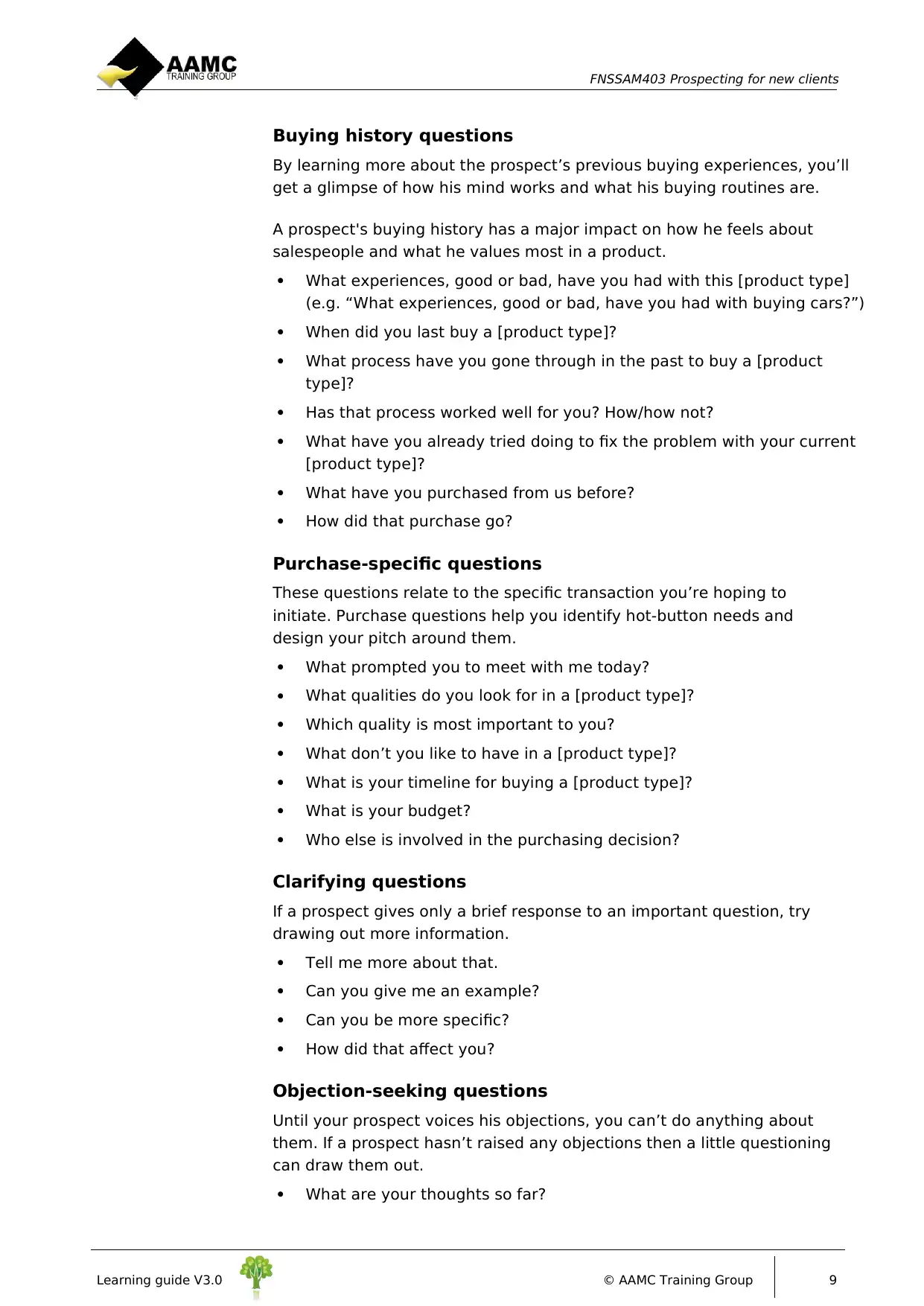
FNSSAM403 Prospecting for new clients
Learning guide V3.0 © AAMC Training Group 9
Buying history questions
By learning more about the prospect’s previous buying experiences, you’ll
get a glimpse of how his mind works and what his buying routines are.
A prospect's buying history has a major impact on how he feels about
salespeople and what he values most in a product.
What experiences, good or bad, have you had with this [product type]
(e.g. “What experiences, good or bad, have you had with buying cars?”)
When did you last buy a [product type]?
What process have you gone through in the past to buy a [product
type]?
Has that process worked well for you? How/how not?
What have you already tried doing to fix the problem with your current
[product type]?
What have you purchased from us before?
How did that purchase go?
Purchase-specific questions
These questions relate to the specific transaction you’re hoping to
initiate. Purchase questions help you identify hot-button needs and
design your pitch around them.
What prompted you to meet with me today?
What qualities do you look for in a [product type]?
Which quality is most important to you?
What don’t you like to have in a [product type]?
What is your timeline for buying a [product type]?
What is your budget?
Who else is involved in the purchasing decision?
Clarifying questions
If a prospect gives only a brief response to an important question, try
drawing out more information.
Tell me more about that.
Can you give me an example?
Can you be more specific?
How did that affect you?
Objection-seeking questions
Until your prospect voices his objections, you can’t do anything about
them. If a prospect hasn’t raised any objections then a little questioning
can draw them out.
What are your thoughts so far?
Learning guide V3.0 © AAMC Training Group 9
Buying history questions
By learning more about the prospect’s previous buying experiences, you’ll
get a glimpse of how his mind works and what his buying routines are.
A prospect's buying history has a major impact on how he feels about
salespeople and what he values most in a product.
What experiences, good or bad, have you had with this [product type]
(e.g. “What experiences, good or bad, have you had with buying cars?”)
When did you last buy a [product type]?
What process have you gone through in the past to buy a [product
type]?
Has that process worked well for you? How/how not?
What have you already tried doing to fix the problem with your current
[product type]?
What have you purchased from us before?
How did that purchase go?
Purchase-specific questions
These questions relate to the specific transaction you’re hoping to
initiate. Purchase questions help you identify hot-button needs and
design your pitch around them.
What prompted you to meet with me today?
What qualities do you look for in a [product type]?
Which quality is most important to you?
What don’t you like to have in a [product type]?
What is your timeline for buying a [product type]?
What is your budget?
Who else is involved in the purchasing decision?
Clarifying questions
If a prospect gives only a brief response to an important question, try
drawing out more information.
Tell me more about that.
Can you give me an example?
Can you be more specific?
How did that affect you?
Objection-seeking questions
Until your prospect voices his objections, you can’t do anything about
them. If a prospect hasn’t raised any objections then a little questioning
can draw them out.
What are your thoughts so far?
⊘ This is a preview!⊘
Do you want full access?
Subscribe today to unlock all pages.

Trusted by 1+ million students worldwide
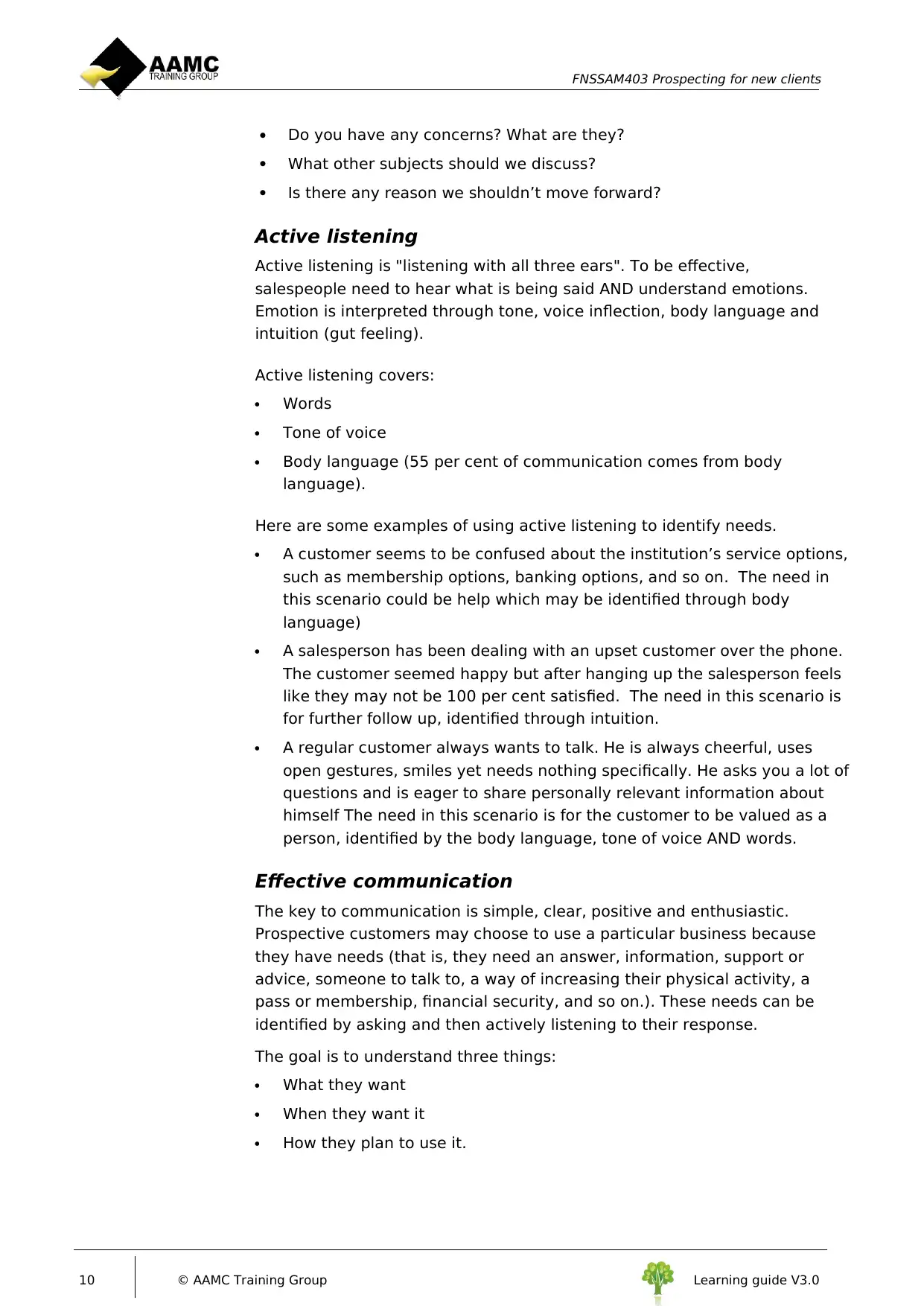
FNSSAM403 Prospecting for new clients
10 © AAMC Training Group Learning guide V3.0
Do you have any concerns? What are they?
What other subjects should we discuss?
Is there any reason we shouldn’t move forward?
Active listening
Active listening is "listening with all three ears". To be effective,
salespeople need to hear what is being said AND understand emotions.
Emotion is interpreted through tone, voice inflection, body language and
intuition (gut feeling).
Active listening covers:
Words
Tone of voice
Body language (55 per cent of communication comes from body
language).
Here are some examples of using active listening to identify needs.
A customer seems to be confused about the institution’s service options,
such as membership options, banking options, and so on. The need in
this scenario could be help which may be identified through body
language)
A salesperson has been dealing with an upset customer over the phone.
The customer seemed happy but after hanging up the salesperson feels
like they may not be 100 per cent satisfied. The need in this scenario is
for further follow up, identified through intuition.
A regular customer always wants to talk. He is always cheerful, uses
open gestures, smiles yet needs nothing specifically. He asks you a lot of
questions and is eager to share personally relevant information about
himself The need in this scenario is for the customer to be valued as a
person, identified by the body language, tone of voice AND words.
Effective communication
The key to communication is simple, clear, positive and enthusiastic.
Prospective customers may choose to use a particular business because
they have needs (that is, they need an answer, information, support or
advice, someone to talk to, a way of increasing their physical activity, a
pass or membership, financial security, and so on.). These needs can be
identified by asking and then actively listening to their response.
The goal is to understand three things:
What they want
When they want it
How they plan to use it.
10 © AAMC Training Group Learning guide V3.0
Do you have any concerns? What are they?
What other subjects should we discuss?
Is there any reason we shouldn’t move forward?
Active listening
Active listening is "listening with all three ears". To be effective,
salespeople need to hear what is being said AND understand emotions.
Emotion is interpreted through tone, voice inflection, body language and
intuition (gut feeling).
Active listening covers:
Words
Tone of voice
Body language (55 per cent of communication comes from body
language).
Here are some examples of using active listening to identify needs.
A customer seems to be confused about the institution’s service options,
such as membership options, banking options, and so on. The need in
this scenario could be help which may be identified through body
language)
A salesperson has been dealing with an upset customer over the phone.
The customer seemed happy but after hanging up the salesperson feels
like they may not be 100 per cent satisfied. The need in this scenario is
for further follow up, identified through intuition.
A regular customer always wants to talk. He is always cheerful, uses
open gestures, smiles yet needs nothing specifically. He asks you a lot of
questions and is eager to share personally relevant information about
himself The need in this scenario is for the customer to be valued as a
person, identified by the body language, tone of voice AND words.
Effective communication
The key to communication is simple, clear, positive and enthusiastic.
Prospective customers may choose to use a particular business because
they have needs (that is, they need an answer, information, support or
advice, someone to talk to, a way of increasing their physical activity, a
pass or membership, financial security, and so on.). These needs can be
identified by asking and then actively listening to their response.
The goal is to understand three things:
What they want
When they want it
How they plan to use it.
Paraphrase This Document
Need a fresh take? Get an instant paraphrase of this document with our AI Paraphraser
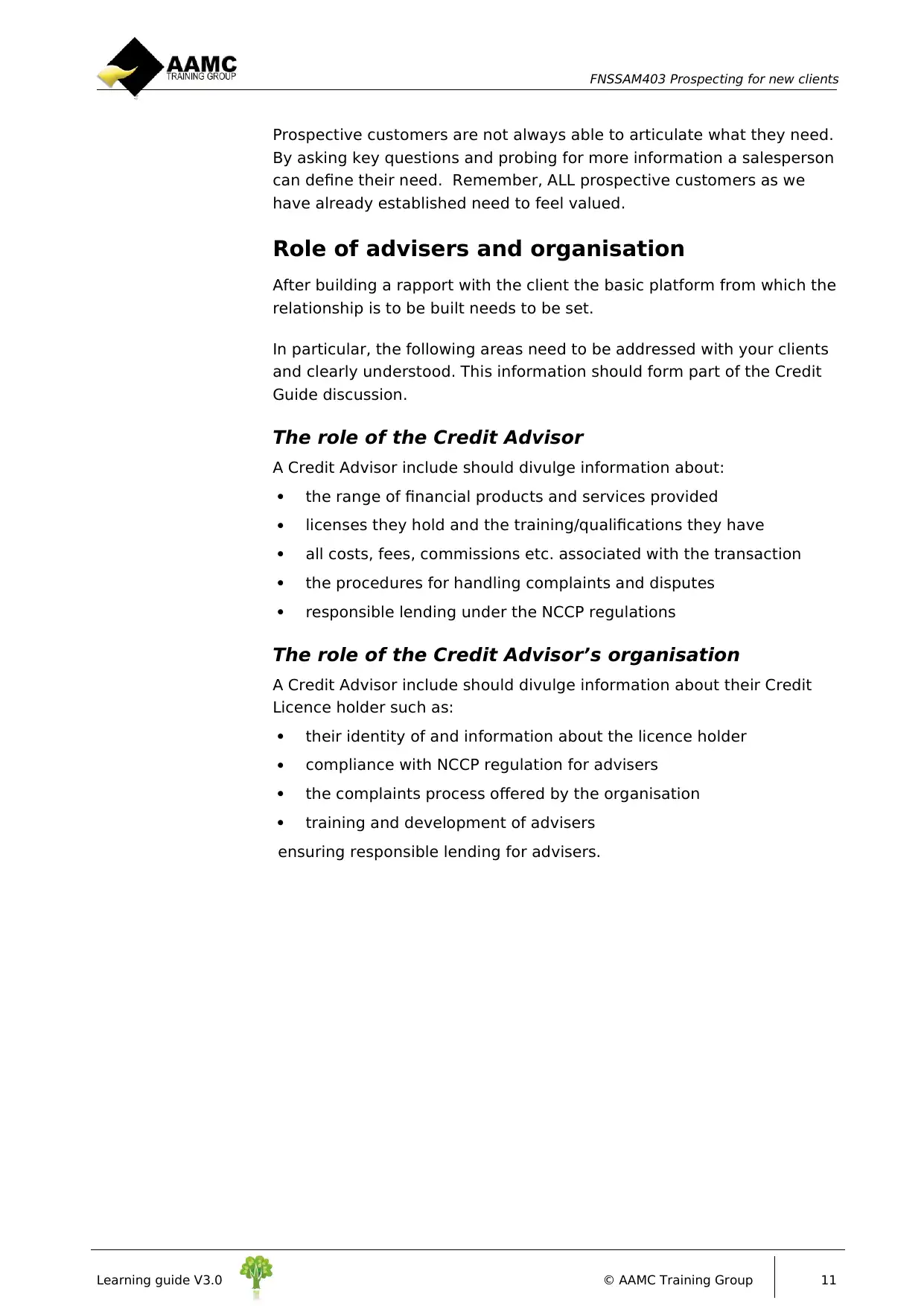
FNSSAM403 Prospecting for new clients
Learning guide V3.0 © AAMC Training Group 11
Prospective customers are not always able to articulate what they need.
By asking key questions and probing for more information a salesperson
can define their need. Remember, ALL prospective customers as we
have already established need to feel valued.
Role of advisers and organisation
After building a rapport with the client the basic platform from which the
relationship is to be built needs to be set.
In particular, the following areas need to be addressed with your clients
and clearly understood. This information should form part of the Credit
Guide discussion.
The role of the Credit Advisor
A Credit Advisor include should divulge information about:
the range of financial products and services provided
licenses they hold and the training/qualifications they have
all costs, fees, commissions etc. associated with the transaction
the procedures for handling complaints and disputes
responsible lending under the NCCP regulations
The role of the Credit Advisor’s organisation
A Credit Advisor include should divulge information about their Credit
Licence holder such as:
their identity of and information about the licence holder
compliance with NCCP regulation for advisers
the complaints process offered by the organisation
training and development of advisers
ensuring responsible lending for advisers.
Learning guide V3.0 © AAMC Training Group 11
Prospective customers are not always able to articulate what they need.
By asking key questions and probing for more information a salesperson
can define their need. Remember, ALL prospective customers as we
have already established need to feel valued.
Role of advisers and organisation
After building a rapport with the client the basic platform from which the
relationship is to be built needs to be set.
In particular, the following areas need to be addressed with your clients
and clearly understood. This information should form part of the Credit
Guide discussion.
The role of the Credit Advisor
A Credit Advisor include should divulge information about:
the range of financial products and services provided
licenses they hold and the training/qualifications they have
all costs, fees, commissions etc. associated with the transaction
the procedures for handling complaints and disputes
responsible lending under the NCCP regulations
The role of the Credit Advisor’s organisation
A Credit Advisor include should divulge information about their Credit
Licence holder such as:
their identity of and information about the licence holder
compliance with NCCP regulation for advisers
the complaints process offered by the organisation
training and development of advisers
ensuring responsible lending for advisers.

FNSSAM403 Prospecting for new clients
12 © AAMC Training Group Learning guide V3.0
12 © AAMC Training Group Learning guide V3.0
⊘ This is a preview!⊘
Do you want full access?
Subscribe today to unlock all pages.

Trusted by 1+ million students worldwide
1 out of 35
Related Documents
Your All-in-One AI-Powered Toolkit for Academic Success.
+13062052269
info@desklib.com
Available 24*7 on WhatsApp / Email
![[object Object]](/_next/static/media/star-bottom.7253800d.svg)
Unlock your academic potential
Copyright © 2020–2025 A2Z Services. All Rights Reserved. Developed and managed by ZUCOL.




